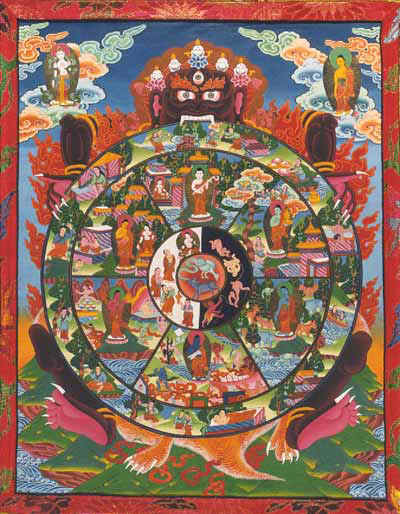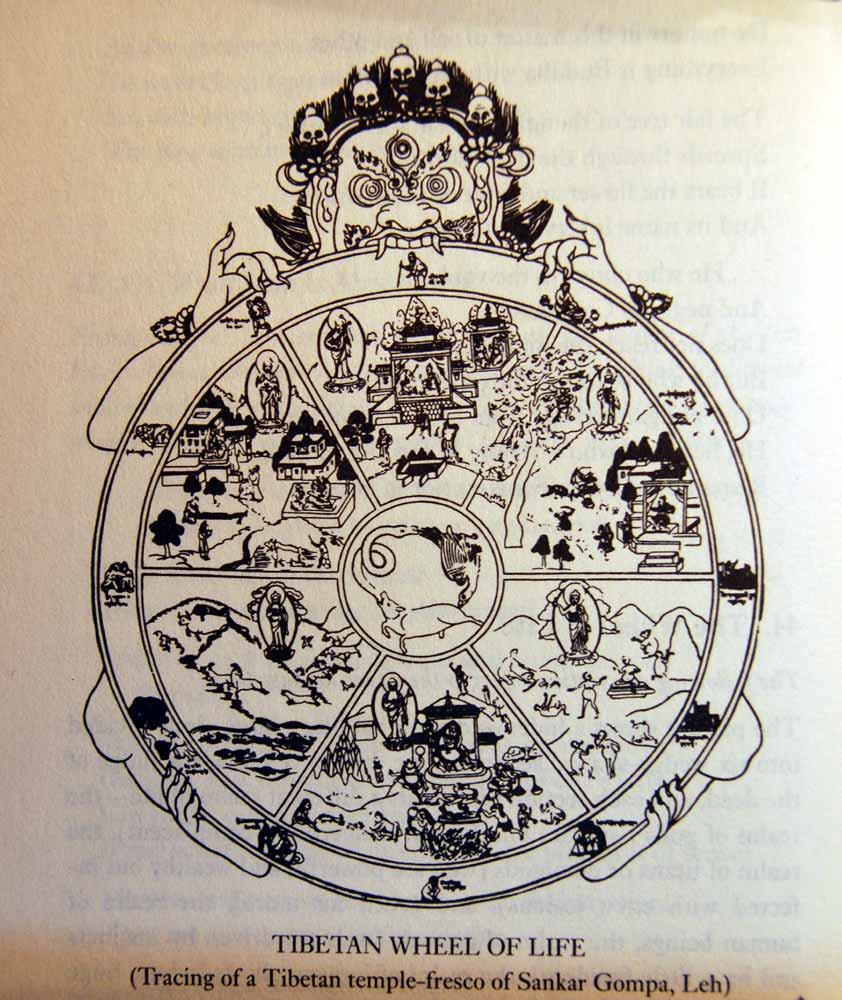 |
 |
| Tibetan Bhavacakra. click to enlarge |
Tibetan Wheel of Life from a Tibetan
temple-fresco of Sankar Gompa, Leh |
Bhavacakra
Wheel of Becoming/Wheel of Life
 |
 |
| Tibetan Bhavacakra. click to enlarge |
Tibetan Wheel of Life from a Tibetan
temple-fresco of Sankar Gompa, Leh |
Bhavacakra or Wheel of Becoming/Wheel of Life is a form of a mandala or tanka (painted wall hanging), used primarily in Tibetan Buddhism. The painting of a tanka is itself a form of mediation. Its meaning is very complex, and can be read to represent at least three different realms of manifested effects of karmic actions. It can be read as a diagram for the six different kinds of existence into which one may be born into during the middle rounds of samsara. It can be read as symbolizing each of the different realms of human existence, lived out by certain kinds of people according to their karmic fortunes of personality type and socioeconomic status. Or it can be read as a description of situations or states of consciousness that everybody passes through again and again in the course of a single day.
Its iconographic meaning is correspondingly complex as well.
In the background are varied Buddhist symbols, such as the moon, clouds in shape of swastika, and always a representation of at least one Buddha or Bodhisattva, seen attempting to help sentient beings to find their way to Nirvana.
The wheel is held by the jaws, hands and feet of the demon, Yama, the judge of the dead, who turns the wheel. Yama represents the ignorance that comes from greed and "selfhood," that keeps the wheel of suffering turning.
The outer rim of the wheel is divided into twelve sections, called the Twelve Interdependent Causes and Effects – 1. ignorance, 2. volitional action or conditioning, 3. consciousness, 4. name and form, 5. six sensory organs (eye, ear, nose, tongue, body and mind), 6. contact or touch, 7. sensation, 8. desire, craving, thirst, 9. grasping, 10. becoming or existence, 11. birth, and 12. decay and death.
The areas between the six spokes represent the six forms of unenlightened existence.
There are six wedged-shaped sections, with each representing a different realm of life –
1. realm of the Gods - Devas (who are blissful but dangerously complacent; always at the top of the wheel)
2. the realm of the titans, demigods and fighting demons - Asuras (lowest rank of gods, who are powerful and wealthy but infected with envy, jealously, and greed for more; always in the upper half of the wheel)
3. the realm of "human beings" (always in the upper half of the wheel)
4. the realm of "animals" (sentient beings, less intellectually advanced than humans, driven by instincts and have little freedom, but can still experience suffering and project karma; always in the bottom half of the wheel; inclusive of birds, fish, and even a worm)
5. the realm of "hungry ghosts" - Pretas (whose huge bellies but pinpoint mouths and eyes suggest insatiable craving; always in the bottom half of the wheel)
6. the realm of "hell beings" (who are consumed with relentless rage; always at the bottom of the wheel; beings brought to hell for past karma, but beings who can escape it through good deeds and reincarnation).
One vision of hell. Photo of painting on canvas, from a guesthouse in Pak Lay, Laos.
At the center or hub of the circle is a smaller circle containing the Three Poisons, within a rim of binary demarcation of black and white. The black section represents the Dark Path on which sentient beings are moving downward to the hellish realms. The white section represents the Path of Bliss on which beings are moving upward to the Godly realms. The Three Poisons are personified as a rooster or fowl, a pig or boar, and a snake, chasing one another around and around. They symbolize the forces that keep people caught up in the samsaric round of existence: the rooster stands for greed, the pig for ignorance or delusion, and the snake for hatred.
The wheel can thus hold distinct meanings, each speaking to different sensibilities.
reference: http://en.wikipedia.org/wiki/Bhavacakra